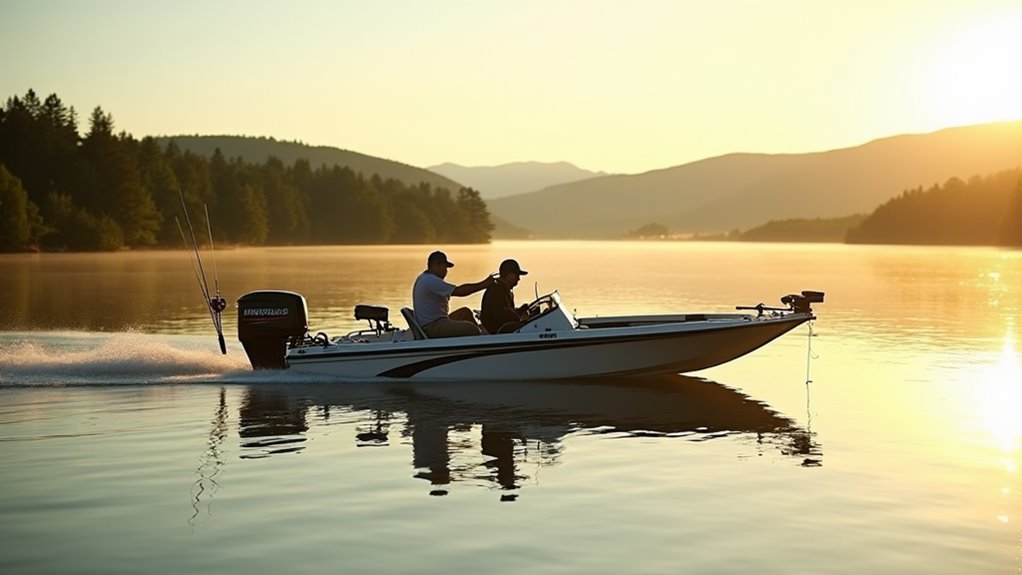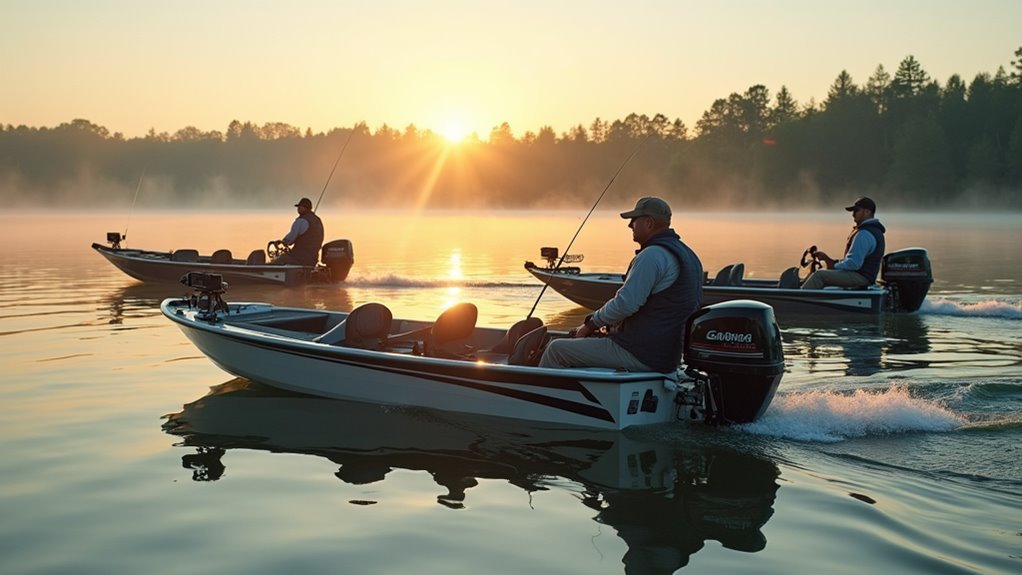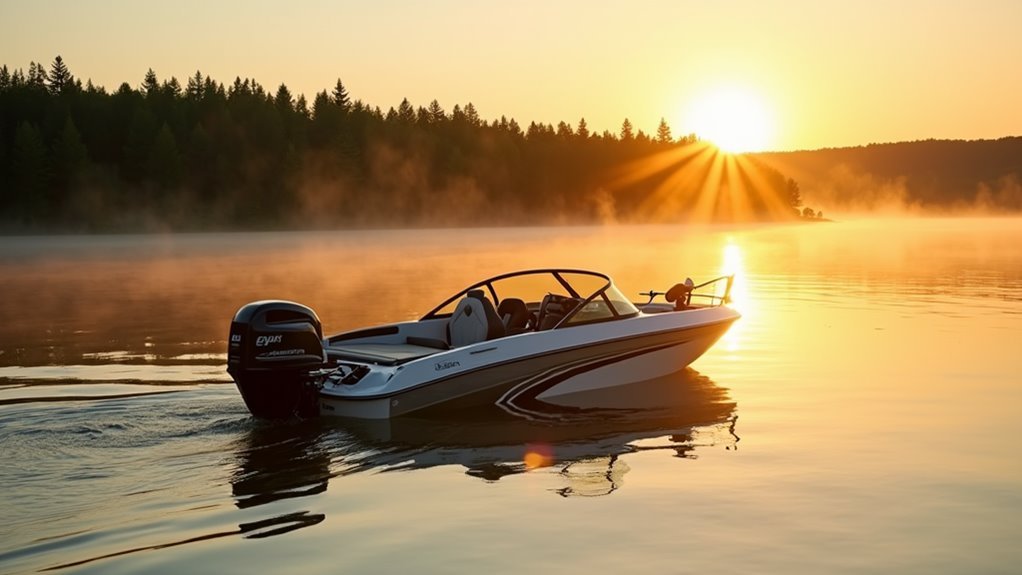Did you know that nearly 70% of boaters could increase their trolling motor's efficiency by aligning the voltage with their boat's weight? We often find ourselves puzzled by the choice between 12V, 24V, or 36V systems, each offering distinct advantages based on boat size and conditions. Understanding which voltage best suits our needs can drastically improve performance and battery life. As we explore the benefits and limitations of each option, we'll uncover practical insights that could enhance every boating adventure. Let's take a closer look at how making the right choice impacts our time on the water.
Understanding Trolling Motor Voltages
Understanding trolling motor voltages is essential for maximizing your boat's performance. We've got the freedom to choose between different voltage systems, like 24V and 36V, but first, let's get clear on why voltage stability and electrical safety matter. When it comes to guaranteeing smooth rides and keeping our journeys safe, the right voltage makes all the difference. A stable voltage means fewer surprises out on the water—no stalled motors or unexpected battery drains.
*Higher voltage systems* not only offer extended runtime and improved efficiency but also require careful consideration of compatibility and installation.
By opting for the right voltage, we secure the power needed for our adventures without compromising safety. Voltage stability guarantees our trolling motor runs efficiently, drawing the correct amount of current, and not overtaxing our system. Both 24V and 36V systems provide this reliability, particularly for medium-sized and heavier boats, as they offer better efficiency and lower current draw. It's important to know that managing more powerful systems requires careful attention to electrical safety. Properly installing batteries in series—whether two 12V for a 24V system or three for a 36V—guarantees efficiency while minimizing risk. Picking the right voltage empowers our maritime experiences with both excitement and safety.
Benefits of 12V Systems

When we're considering versatility and practicality, a 12V trolling motor system is often the go-to choice for smaller boating setups. It's perfect for those of us who prefer the freedom of light travel and fewer complexities on the water.
Imagine the weight savings we gain with this setup; it's suitable for boats under 1,000 pounds, like those trusty aluminum ones we use for panfish fishing. This system is a practical option for calm waters and basic trolling needs. With less current draw compared to higher voltage systems, it increases battery life—an advantage for those who want to make the most out of their fishing excursion.
Now, let's talk about cost-effectiveness. A 12V system doesn't ask us to break the bank. With a lower upfront cost compared to its 24V and 36V cousins, it's a budget-friendly solution.
Plus, the smaller battery size is space-efficient, requiring less of our investment. Not to mention, replacement batteries are easier to find and won't cost a fortune.
Handling a 12V system is a breeze. The batteries are lighter and more compact, making installation and maintenance a cakewalk.
We don't have to wrestle with intricate wiring, and standard batteries will do just fine for charging. For those environmentally minded, it offers lower energy consumption and fewer battery replacements.
It's simplicity at its best.
Advantages of 24V Motors

While the 12V trolling motor systems serve us well in smaller setups, stepping up to a 24V system offers incredible performance and efficiency for those needing a bit more power. Imagine more freedom on the water as we navigate larger boats, where increased thrust from a 24V system propels us with ease, even in choppy conditions.
These motors optimize power to deliver longer runtimes, efficiently transferring energy from battery to motor with minimal loss. This means we spend less time worrying about battery life and more time enjoying our adventure. With the right battery configuration, motors with 55-80 lbs. of thrust can effectively operate using 24V systems, providing the necessary power without overexerting the batteries.
With a 24V setup, motor efficiency is a key advantage. By drawing only half the current compared to a 12V motor at the same power level, it substantially reduces strain on the battery. This efficiency in power optimization lends itself to longer, carefree adventures on the water.
We also benefit from reduced voltage drop and power loss in wiring, enhancing overall performance.
Though 24V systems come with larger battery banks, requiring more expertise for setup, they repay us with longevity and cost-efficiency over time. Whether we're cruising along serene lakes or battling strong currents, these motors meet our needs with resilience and reliability.
Why Choose 36V Options

Exploring the capabilities of a 36V trolling motor, we discover power and performance suited for substantial tasks on the water. We feel the thrill of skimming across waves with speed and grace, especially when heavy duty fishing demands the best. For those of us who love professional angling or tackling challenging conditions, this motor is ideal. It fits larger boats under 120 pounds, effectively managing 16-18 foot vessels loaded with people and gear. Whether handling heavy fiberglass bass boats over 1,800 pounds or traversing rough waters, the 36V option is a game changer. Higher voltage results in increased thrust, faster speeds, and better battery efficiency, which can significantly enhance your boating experience.
Here's why it stands out:
| Feature | Description | Benefit |
|---|---|---|
| Power & Thrust | Offers 100 lbs of thrust | Handles heavy loads effortlessly |
| Efficient Battery Use | Less current draw | Longer runtime, up to 14 hours |
| Smooth Control | Maneuverable in rough waters | Better control in wind & waves |
Choosing this motor, we benefit from extended use without frequent battery swaps. A high-quality battery highlights its efficiency, making our adventures more enjoyable. So let's embrace the freedom of the open water, where our limits are only defined by our spirit of adventure.
Comparing Performance and Power

Traversing the intricate world of trolling motor voltage options, we uncover the distinct advantages that each system offers in both performance and power. Choosing between 12V, 24V, or 36V systems isn't just about numbers—it's about how these voltages translate into Voltage Efficiency and Power Output on the water.
A 12V system offers simplicity, often sufficient for smaller boats needing less than 55 lbs of thrust. Its compact setup with a single battery might appeal to those who crave simplicity but may fall short for heftier tasks.
For the mid-sized aficionados, the 24V option delivers more punch, boasting roughly 90 lbs of thrust. Its two-battery requirement yields significant runtime, ensuring power freedom without frequent interruptions.
Jumping to 36V transforms the water experience with approximately 110 lbs of thrust, perfect for tackling strong currents or heftier boats. Although they demand three batteries, the improvement in Power Output can turn challenging conditions into smooth sailing.
Many boat enthusiasts consider using a higher voltage system due to its efficient power use and longer runtime, which supports more demanding aquatic environments. No matter our choice, it's about aligning the motor's power with our aquatic pursuits. Whether seeking an efficient glide or robust speed, discerning how voltage affects performance and power helps steer us toward our perfect trolling companion.
Impact on Battery Life

Understanding the different performance levels of trolling motor voltages sets the stage for exploring their impact on battery life. We're aware that the choice of voltage for our trolling motor—whether 12V, 24V, or 36V—affects not just the runtime, but also how efficiently our batteries use power. Higher voltage systems stand out by offering longer runtimes and better battery efficiency, which means less heat and longer periods on the water without interruption. Lithium batteries, for example, have a 100% depth of discharge, allowing you to utilize the entire stored capacity without risk of damage, unlike their lead acid counterparts. Besides, proper charging practices play a big role in keeping our batteries in top shape. Let's plunge into some factors that influence battery life:
- Battery efficiency: Higher voltage systems are more efficient, requiring less current for the same power output, thereby extending battery life.
- Charging practices: Engaging in regular recharges and seasonal maintenance extends battery lifespan.
- Battery capacity: Higher voltage systems usually involve larger battery banks, enhancing overall energy storage.
- Power draw: We enjoy longer outings as these systems draw less current, extending how long we can stay out on the water.
Selecting for Your Boat Type

When it comes to choosing the right trolling motor voltage for your boat, understanding the specific needs of different boat sizes is crucial. Smaller boats, preferably under 1000 lbs and smaller than 15 feet, benefit most from a 12V system. They're straightforward and effective for those basic trolling needs, ensuring boat stability without overwhelming complexity. It keeps our user experience smooth and focused, perfect for those of us who relish the freedom of a simple, carefree boating excursion.
Meanwhile, medium-sized boats weighing between 1000-1500 lbs and measuring 16-19 feet thrive with a 24V setup. This balance of power and efficiency delivers more thrust and longer runtime, enhancing stability as we navigate through our favorite waters. Given that a 24-volt motor needs two batteries, it's an ideal choice for moderate use without stretching the budget.
For larger boats over 1500 lbs and larger than 20 feet, the robust 36V option prevails. It offers maximum power and efficiency needed for stability in demanding conditions. Even if it costs more, the user experience is enhanced with greater thrust and longer trips, granting us the liberty to explore further. Remember, aligning the trolling motor with your boat's size optimizes its functionality and your enjoyment out on the water.
Frequently Asked Questions
How Do Environmental Conditions Affect Trolling Motor Performance?
When we face environmental conditions, water clarity affects motor efficiency and temperature fluctuations impact battery performance. These challenges can limit our adventures, but choosing the right equipment guarantees we maintain freedom and explore without constraints.
Can I Switch Between Different Voltage Motors Easily?
Switching voltage motors might seem liberating, but voltage compatibility socks us with limitations. Motor interchangeability isn't seamless; it demands costly new wiring and components, challenging our sense of freedom. Compatibility isn't just plug-and-play, unfortunately.
Are There Specific Maintenance Tips for Prolonging Motor Life?
We understand that preserving our trolling motor's life is vital. Let's focus on battery care and regular motor cleaning. They guarantee freedom on the water. Inspect batteries, charge properly, clean the motor, and routinely check for wear.
What Are the Typical Costs Associated With Each Motor Type?
Imagine the thrill of gliding freely across water; battery cost varies with motor efficiency, power output, and durability factors. 12V systems cost $300-$500, 24V costs $1,200-$2,500, and 36V ranges $2,500-$4,000, providing lasting adventure.
How Do These Motors Impact Overall Boat Weight and Balance?
We've noticed that trolling motors affect structural integrity and weight distribution substantially. Let's keep our boat steady by considering motor placement and battery weight. It's vital for stability and guarantees we maintain our freedom on the water.
Conclusion
After exploring trolling motor voltages, let's remember: "Measure twice, cut once." It means making the right choice from the start will save us time and effort later. Whether it's a 12V for simplicity, a 24V for balance, or a 36V for maximum power, aligning with our boat's needs is key. By picking the right setup, we guarantee better performance and longer battery life, creating smooth sailing on every trip. Let's get it right, together